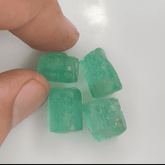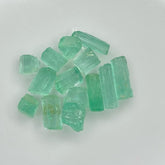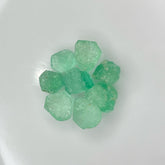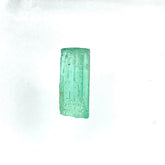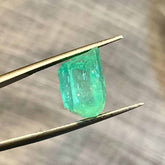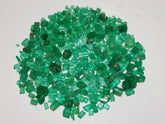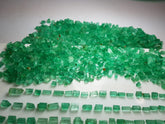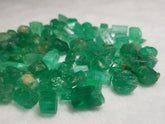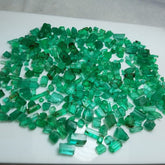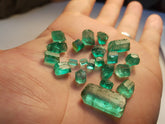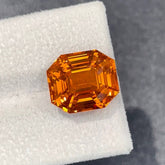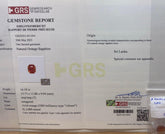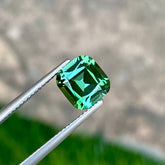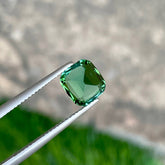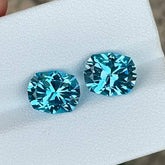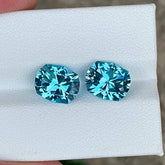Filter
19 results
30
- 10
- 15
- 20
- 25
- 30
- 50
Date, new to old
- Featured
- Best selling
- Alphabetically, A-Z
- Alphabetically, Z-A
- Price, low to high
- Price, high to low
- Date, old to new
- Date, new to old
Sort
Sort by:
- Featured
- Best selling
- Alphabetically, A-Z
- Alphabetically, Z-A
- Price, low to high
- Price, high to low
- Date, old to new
- Date, new to old
-
Magic Mint Emerald Facet Rough
Product Information: Rough Gemstone Magic Mint Emerald Facet Rough Weight 10.55 carats Average Weight 3.51 carats Clarity Slightly Included (SI) No. of Pieces 03 Origin Afghanistan Treatment None Description: The name Emerald derives from the ancient word “smaragdos,” meaning “green stone.” Its green color...- $365.00
- $365.00
- Unit price
- / per
-
30.90 carats Beautiful Facet Rough Emerald Crystals
30.90 carats Beautiful Facet Rough Emerald Crystals are available for sale at wholesale price from Panjshir Kamar Sufaid, Afghanistan. Product Information: Gemstone Name Beautiful Facet Rough Emerald Crystals Weight 30.90 carats Average Weight 7.725 carats Origin Panjshir Kamar Sufaid, Afghanistan No. of Pieces 04...- $1,390.00
- $1,390.00
- Unit price
- / per
-
32.30 carats Beautiful Facet Rough Emerald Lot
32.30 carats Beautiful Facet Rough Emerald Lot is available for sale at wholesale price from Panjshir Kamar Sufaid, Afghanistan. Product Information: Gemstone Name Beautiful Facet Rough Emerald Lot Weight 32.30 carats Average Weight 2.13 carats Origin Panjshir Kamar Sufaid, Afghanistan No. of Pieces 14...- $835.00
$850.00- $835.00
- Unit price
- / per
-
36 carats Panjshir Emerald Facet Rough
36 carats Panjshir Emerald Facet Rough is available for sale at wholesale price from Panjshir Kamar Sufaid, Afghanistan. Product Information: Gemstone Name Panjshir Emerald Facet Rough Weight 36 carats Average Weight 4.5 carats Origin Panjshir Kamar Sufaid, Afghanistan No. of Pieces 08 Treatment None...- $1,260.00
- $1,260.00
- Unit price
- / per
-
35 carats Emerald Crystals Facet Rough
35 carats Emerald Crystals Facet Rough is available for sale at wholesale price from Panjshir Kamar Sufaid, Afghanistan. Product Information: Gemstone Name Emerald Crystals Facet Rough Weight 35 carats Average Weight 2.5 carats Locality Panjshir Kamar Sufaid, Afghanistan No. of Pieces 14 Treatment None...- $765.00
$777.00- $765.00
- Unit price
- / per
-
6.55 carats Facet Grade Rough Emerald Crystal
6.55 carats Facet Grade Rough Emerald Crystal which is available for sale at wholesale price from Punjshir, Afghanistan. Product Information: Gemstone Name Facet Grade Rough Emerald Crystal Weight 6.55 carats Dimension 16.5 x 7 x 6 mm Locality Punjshir, Afghanistan Clarity Slightly Included Treatment...- $385.00
- $385.00
- Unit price
- / per
-
44.20 Carats Beautiful Vivid Green Facet Rough Emerald Lot
Product Information: Gemstone Name Beautiful Vivid Green Facet Rough Emerald Lot Weight (in grams) 8.84 grams Weight (in carats) 44.20 carats Average Size 2 carats No. of Pieces 22 Locality Panjshir, Afghanistan Clarity SI / Eye Clean Treatment None Shape Raw Description: The name...- $1,300.00
$1,500.00- $1,300.00
- Unit price
- / per
-
6.35 Carats Beautiful Cutting Grade Rough Emerald from Afghanistan
Product Information: Gemstone Name Beautiful Cutting Grade Rough Emerald Weight (in grams) 1.27 grams Weight (in carats) 6.35 carats Dimension 12.5 x 9 x 8 mm Locality Punjshir, Afghanistan Treatment None Shape Raw Description: The name Emerald derives from the ancient word “smaragdos,” meaning...- $500.00
- $500.00
- Unit price
- / per
-
8.80 Carats Beautiful Big Size Facet Rough Emerald from Afghanistan
Product Information: Gemstone Name Beautiful Big Size Facet Rough Emerald Weight (in grams) 1.76 grams Weight (in carats) 8.80 carats Dimension 12.5 x 9 x 9 mm Locality Punisher, Afghanistan Treatment None Shape Raw Description: The name Emerald derives from the ancient word “smaragdos,”...- $750.00
- $750.00
- Unit price
- / per
-
Emerald Facet Rough Emerald
Good Color Beautiful Facet Rough Emerald from the mines of Punjshir, Afghanistan available at Emerald Facet Rough Emerald. It is Untreated and Natural. Weight: 100 Carats Biggest Size: 11 Carats Smallest Size: 2.5 Carats Average Size: 4.1 Carats Treatment: None Clarity: Clean To Light...- $2,890.00
- $2,890.00
- Unit price
- / per
-
Beautiful Facet Rough Small Size Emerald from Punjshir
The name Emerald derives from the ancient word “smaragdos,” meaning “green stone.” Its green color is incomparable and is therefore highly evaluated for its deep, bright green color, and transparency. Looking at an exquisite emerald is a truly breathtaking sight and deserves its place...- $5,500.00
$6,000.00- $5,500.00
- Unit price
- / per
-
Buy Facet Grade Rough Emeralds Lot available for sale
Buy Facet Grade Rough Emeralds Lot which is available for sale at gandharagems. The price of this Facet Grade Rough Emeralds Lot in USD is $17.5 per carat. Weight 510 carats Treatment None Origin Panjsher, Afghanistan Maximum size 10 ct Type Facet Rough Average...- $8,925.00
- $8,925.00
- Unit price
- / per
-
Facet Grade Rough Emeralds Lot available for sale
Buy Facet Grade Rough Emeralds Lot which is available for sale at gandharagems. Weight 1400 carat Treatment None Origin Panjsher, Afghanistan Maximum size 23 ct Kindly message for more queries and price- $1.00
- $1.00
- Unit price
- / per
-
Buy Facet Grade Rough Emeralds Lot available for sale
Buy Facet Grade Rough Emeralds Lot which is available for sale at gandharagems. The price of this Facet Grade Rough Emeralds Lot is $12 per carat. Weight: 130 carat Treatment: None Origin: Panjsher, Afghanistan Maximum size: 8 carats Average size: 2 3 carat Price...- $1,560.00
- $1,560.00
- Unit price
- / per
-
A beautiful piece of Emerald from the Valley of Swat
A beautiful piece of Emerald from the Valley of Swat, Pakistan. You can see inclusions there but the piece is very beautiful in colour and is translucent which is not that much available in Swat Emerald. Beautiful Emerald from Swat Weight: 05.80 Carats Shape:...- $450.00
- $450.00
- Unit price
- / per
-
Facet Grade Emerald from the mines of Panjshir
Facet Grade Emerald from the mines of Punjshir, Afghanistan at Gandhara Gemstones. Selected the best available pieces from the lot. Facet Grade Emerald Average size: 5 Carats Weight: 360 Carats / 72 Grams Treatment: Not Heated Nor Oiled Shipping Thailand Post $12 DHL Express...- $12,500.00
- $12,500.00
- Unit price
- / per
-
Facet Grade Rough Emeralds available for sale
Buy Facet Grade Rough Emeralds from Panjsher, Afghanistan Origin are available for sale at Gandhara Gemstones. Its price is starting from $33 per carat. Facet Grade Rough Emeralds Weight: 400 carats Treatment: None Origin: Panjsher, Afghanistan Maximum size: 23 carat Type: Facet Grade Price...- $33.00
- $33.00
- Unit price
- / per
-
Facet Grade Rough Emeralds Lot available for sale
Buy Panjsher facet Grade Rough Emeralds Lot available for sale at gandharagems. Facet Grade Rough Emeralds Weight: 295 carat Treatment: None Origin: Panjsher, Afghanistan Maximum size: 5.75 ct Type: Facet Grade Price per carat: $12 Worldwide shipping through DHL Payment through PayPal and western...- $3,540.00
- $3,540.00
- Unit price
- / per
-
Beautiful Facet Grade Emerald from Punjshir
Beautiful Color Facet Rough Emerald Out of the mines of Punjshir, Afghanistan. It is Untreated and Natural. It has 40.6 Grams / 203 Carats of Weight and 2.25 Carats / 11.80 Carats of Size. Weight: 40.6 Grams / 203 Carats Sizes: 2.25 Carats /...- $35,525.00
- $35,525.00
- Unit price
- / per

